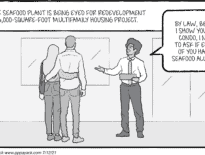Life may have largely returned to what passes for “normal” in Massachusetts these days, but for Boston office landlords, developers and investors it’s anything but.
By the end of the second quarter, daily occupancy at downtown offices had hit 18 percent in some buildings and the pace of negative net absorption slackened, according to Newmark research, marked improvements over the first quarter thanks to the millions of COVID-19 vaccines delivered over the last three months. And while downtown’s streets aren’t yet back to their pre-pandemic buzz at lunchtime, things are looking livelier.
The signs were positive enough that developer Skanska USA recommitted to building its proposed, 625,000-square-foot 380 Stuart St. tower in Back Bay as office-only last month, without the lab component so many have turned to.
But, as the New York Times reported last week citing CoStar data, Boston has the most office-heavy downtown of any major American city, with 83 percent of buildings being largely dedicated to office uses. That ratio may get even more skewed as millions of square feet of new space comes to market via the Winthrop Center, South Station and One Congress towers, State Street Corp.’s planned move from One Lincoln to One Congress and renovations at One Post Office Square.
So far, many companies aren’t ready to radically downsize their office footprints. But with many seeking shorter, more flexible lease terms, brokerage researchers say, change – whatever form it takes – is certainly coming to the way white-collar firms work, and it will clearly reverberate loudly across downtown Boston.
HYM Investments may have seen the writing on the wall when it decided to swap out a planned hotel-retail complex in the last phase of the Bulfinch Crossing project downtown for over 400,000 square feet of life sciences space.
But the landlords and investors behind existing downtown and Back Bay buildings won’t likely be able to respond so nimbly to long-term changes in the office market. With Boston’s arcane planning and zoning process, it won’t matter whether a conversion to labs, housing or something else becomes the smart play – their hands will be tied, or at least seriously restricted.
Valuable commercial property is a cornerstone of Boston’s municipal finances. The city takes in nearly $2.5 billion each year in property taxes, 71 percent of its overall revenues. And thanks to tremendous growth in the Seaport District and elsewhere, the city has enjoyed a comfortable cushion between the maximum 2.5 percent of property value it can legally tax and what it needs to spend.
With the city staring down numerous complex challenges, from housing costs to climate change, city leaders need to start developing options now for giving downtown landlords a menu of realistic options that will make sure their buildings retain significant value.
Letters to the editor of 300 words or less may be submitted via email at editorial@thewarrengroup.com with the subject line “Letter to the Editor,” or mailed to the offices of The Warren Group. Submission is not a guarantee of publication.





